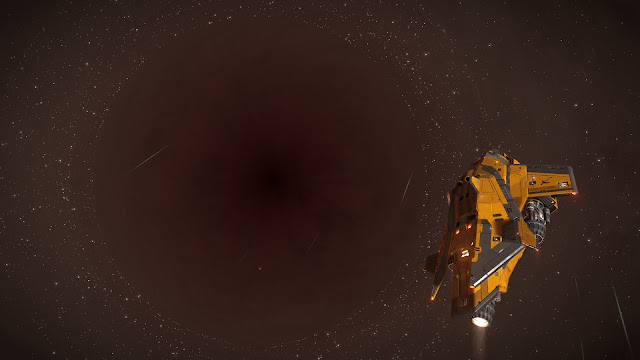Just past the largest black hole at the centre of the galaxy, up a bit and over to the left, the high density of ordinary stars are heavily dusted with compact, hot and dangerous neutron stars. I found myself on the edge of this field after a sideways hop from Sagittarius A* to another nearby black hole with a GRS designation, coordinates provided by a fellow explorer.
Judged to be the remnants of a super nova, a neutron star is dense, hot and spinning. The sheer number of them in this volume of space calls into question what stellar event took place here. One that left behind so many?
The calmness of space of the moment actually conceals the vicious damage once wrought here. A massive star near the end of its main sequence, and in the final stages of collapse, will shrink further under its nuclear processes. Beyond a certain point the outer shell is blown away while a core of neutrons remains. A super nova is the death of a star.
Known to explorers as "The Neutron Fields", it is more like a battle field graveyard of giant fallen stars.
While it has become routine and safe exploration there a few things to keep an eye on. Such a star has an intense heat output that can overwhelm a ship's cooling systems very quickly. The distance between safe scanning and burnout can be a matter of seconds, and even turning away to try and make safe distance can bring you into danger.
A neutron star is so small that there is only a brief visual distortion on the exit of hyperspace to show where it lies. The brightest point in the nights sky for its proximity, but otherwise a point like body that is lost in the backdrop of stars. There's also no refuelling here, unless you're lucky with a companion star.
These systems are undergoing regeneration, however, showing that from the death of a star there is a rebirth. Companion stars, dense metallic worlds and gas giants form a respectful distance away from the neutron star at the centre of the system.
That regeneration can also include new life from the fallen star, carrying its own charm, beauty, and creativity.
So when I found them, I called them The Three Graces.
Three water worlds suitable for terraforming, in tight orbit around each other and huddled in protection from this neutron star. There is already carbon-water based life here, on three planets within 12 light seconds from each other, in the remnants of a dead star.
A rather unusual late sequence S-type star also caught my eye: the first I have ever seen. A detailed sensor pass for the scientists back home, but not much more to report.
Then its back towards Sol. Narrow band comms chatter with fellow explorers helps me realise that I'm not best equipped for a longer and more extended journey out here. In particular I don't have the jump range to attempt trips out to the sparse edge of the galaxy.
So with databanks brimming with data, thoughts now turn to a small bubble of intensely occupied space, where fragile life thrives and fights to survive.



















































